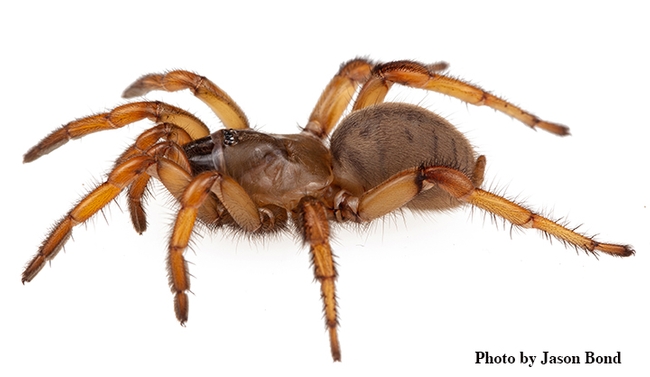
First, the grant:
Jason Bond, professor and the Schlinger Chair in Insect Systematics, UC Davis Department of Entomology and Nematology, has received a 4-year, $1.4 million National Science Foundation grant to study trapdoor spiders in the California Floristic Province.
“The idea is to look at the genomic diversity of trapdoor spider populations across the California landscape and identify new species and hotspots of diversity,” said Bond, principal investigator of the collaborative award, shared with Marshal Hedin, professor of biology at San Diego State University (SDSU).
“From a research perspective, this is pretty exciting but it also includes a really nice educational component working with Fran Keller at Folsom Lake College (a UC Davis alumnus),” Bond said. “We have REU (Research Experiences for Undergraduates) funding for students who will be transferring to UC Davis.”
Also working on the grant is co-PI James Starrett, project scientist in the Bond lab.
Trapdoor spiders construct their burrows with a corklike or wafer trap door made of soil, vegetation and silk. They belong to a number of related families placed in the order Araneae, including Euctenizidae and Halonoproctidae.
The researchers also will be using “crowdsourced” data from iNaturalist, involving public sightings of spiders.
The California Floristic Province is a floristic province with a Mediterranean-type climate on the Pacific Coast. In addition to its remarkable spider diversity, this biodiversity hotspot is known for its giant sequoias and coastal redwoods.
“One of the first products from the project will be the description of a new trapdoor spider genus and species from Moss Landing State Beach,” Bond said. Plans call for the public to suggest candidate names for the new species, with the Bohart Museum of Entomology selecting the winner.
The grant is titled “Collaborative Research: Phylogenomics, Spatial Phylogenetics and Conservation Prioritization in Trapdoor Spiders (and Kin) of the California Floristic Province.”
The abstract: “Using a combination of original fieldwork, newly developed analytical methods for genetically identifying species and their evolutionary and geographic relationships, this research project will focus on trapdoor spiders and their relatives as an exemplary group for biodiversity knowledge and conservation in the California Floristic Province (CA-FP). Long-term surveys will be conducted at multiple geographic locations that include most major CA-FP habitat types. At these sites, the presence of spider species and the numbers of individuals in each will be measured to provide a statistical baseline for future monitoring efforts. New large DNA datasets, based on analysis of thousands of genes, will be generated by analysis of the genomes of these species.”
“New methods will be applied to this data to identify species boundaries, and formal taxonomic descriptions will be made for all new species,” according to the abstract. “The new information about these new species and their genetic relationships will be used to assess patterns of biodiversity in this spider group across the complex geography of the CA-FP. Statistical comparisons of the geographic patterns of spider species distribution will be made to CA-FP plants and vertebrates, and these results will be used to determine whether biodiversity hotspots coincide with federal, state, and locally protected areas.”
“This project will train students and other researchers in several techniques of field biology research, producing and analyzing new data from genomes, using cutting edge methods. This research will encourage participation and train a select group of community college students from underrepresented groups who plan to transfer to Science, Technology, Engineering, and Math (STEM) programs in four-year colleges.”
Bond and colleagues recently published research in the journal Systematic Biology that recognizes eight new spider families—five elevations in rank and three brand new family level rank names, along with one new subfamily. This is in addition to other new families that Bond and Hedin proposed last year. Postdoctoral researcher Vera Opatova of the Bond lab (she recently left for a position in Prague), is the first author on the Systematic Biology paper, "Phylogenetic Systematics and Evolution of the Spider Infraorder Mygalomorphae Using Genomic Scale Data," and Bond is the senior author.
Hedin is the principal investigator of a continuing grant, “Collaborative Research: Phylogenomics, Spatial Phylogenetics and Conservation Prioritization in Trapdoor Spiders (and Kin) of the California Floristic Province,” with co-principal investigator and Jeet Sukemaran, SDSU assistant professor who specializes in computational evolutionary biology.
Attached Images:
